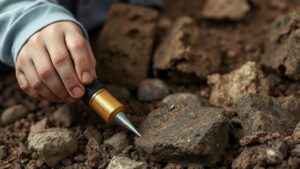Techniques for Finding Burial Goods Without Disrupting Sacred Areas
Techniques for Finding Burial Goods Without Disrupting Sacred Areas
The sensitive nature of burial sites and the artifacts associated with them poses a significant challenge for archaeologists and cultural heritage professionals. The quest for knowledge must be balanced with respect for the sanctity of such sites. This article delves into advanced techniques for locating burial goods without physical disruption and explores methods that uphold ethical and cultural considerations.
Understanding the Importance of Sacred Areas
Burial sites are often regarded as sacred spaces that carry immense historical, cultural, and spiritual significance. Disturbing these areas can lead to irreparable damage, loss of context, and potential disrespect to the ancestors and communities involved. Archaeologists need to approach these sites with a strategy that honors their cultural importance while pursuing legitimate scientific inquiry.
Remote Sensing Technologies
Remote sensing technologies offer a non-invasive means to locate burial goods without disturbing the soil or the associated artifacts. These methods include ground-penetrating radar (GPR), aerial photography, and satellite imagery.
- Ground-Penetrating Radar (GPR): GPR utilizes radar pulses to image the subsurface. It can detect anomalies indicative of burial sites, such as voids created by coffins or artifacts. For example, GPR has been successfully used in archaeological sites like the Roman cemetery in Wilshire, UK, allowing researchers to map the extent of the site without excavation.
- Aerial Photography and LiDAR: Aerial photography, combined with LiDAR (Light Detection and Ranging), can reveal structural features beneath dense foliage. This technique has proven effective in areas like the ancient Mayan cities of Central America, where it uncovered earthworks and structures previously hidden by vegetation.
Electromagnetic Induction Surveys
Electromagnetic (EM) induction surveys offer another avenue for locating burial goods. EM surveys detect variations in the Earths magnetic field caused by metal artifacts. This method is particularly useful for uncovering metallic objects, including burial goods, without excavation.
An exemplary application of this technique occurred during the investigation of an ancient Native American burial ground in the Midwest United States. EM surveys revealed the presence of metal artifacts buried over a century ago, allowing archaeologists to map the site accurately while maintaining its integrity.
Geophysical Investigations
Geophysical investigation techniques can provide a comprehensive understanding of subsurface conditions without excavation. Techniques such as resistivity survey and seismic reflection aid in locating and characterizing burial sites.
- Resistivity Survey: This technique measures the electrical resistance of soil. Differences in resistivity can indicate the presence of features like graves or buried goods. A notable case occurred at the Elizabethan burial site of St. Mary’s Church, where resistivity surveys accurately located grave shafts before manual verification.
- Seismic Reflection: Seismic reflection involves sending shock waves into the ground to identify subsurface structures. This method has been effective in large archaeological surveys, offering insights into extensive burial sites.
Community Engagement and Traditional Knowledge
Integrating community engagement and traditional knowledge into archaeological practices is crucial for locating burial goods respectfully. Collaborating with local communities can provide contextual insights, such as oral histories that may indicate the presence of burial sites.
For example, the collaboration between archaeologists and Indigenous communities in North America has led to the careful identification of sacred burial areas. e partnerships help ensure that archaeological work is conducted with the consent and guidance of the community, fostering an ethical approach to heritage management.
Case Studies of Successful Non-Disruptive Methods
Several case studies illustrate the efficacy and ethical considerations of non-invasive techniques in locating burial goods. One notable example is the use of GPR at the Celtic burial site near Glasgow, Scotland. Researchers employed GPR to identify burial mounds and associated artifacts without disturbing the site, enabling them to gather valuable data while preserving the integrity of the burial context.
Another significant example involves the collaboration between academia and local tribes in California, where aerial surveys helped locate ancient burial grounds. This project ensured that any potential excavation was limited and aligned with tribal customs, providing protections for sacred sites.
Actionable Takeaways
For professionals engaged in archaeology or cultural heritage, several key takeaways can aid in the ethical pursuit of knowledge regarding burial goods:
- Employ non-invasive technologies, such as GPR, EM surveys, and resistivity studies, to locate artifacts without excavation.
- Engage with local communities to incorporate traditional knowledge into archaeological research.
- Ensure compliance with ethical standards and cultural sensitivity guidelines in all undertakings.
- Advocate for the use of interdisciplinary methods, combining technological advances with anthropological insights.
To wrap up, the respectful pursuit of knowledge regarding burial goods can be achieved through non-invasive techniques, community engagement, and ethical practices. By prioritizing the sanctity of sacred areas, researchers can uncover valuable historical insights while honoring the cultural significance of burial sites.


